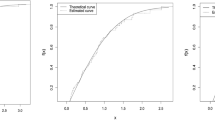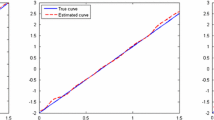Abstract
In this paper, we investigate the rates of strong consistency and the strong representations for the Kaplan–Meier estimator and hazard estimator with censored widely orthant dependent data. Under some mild conditions, the rates of strong consistency are shown to be \(O(n^{-1/2}[\ln (ng(n))]^{1/2})~a.s.\), where g(n) are the dominating coefficients of widely orthant dependent random variables. Under the same conditions, the strong representations of the two estimators are also obtained with the remainder of order \(O(n^{-1/2}[\ln (ng(n))]^{1/2})~a.s.\) As an application, the results are generalized to Farlie-Gumbel-Morgenstern sequences. These results extend the corresponding ones for independent and some dependent data. Some numerical simulations and a real example analysis are also presented to confirm the theoretical results.



Similar content being viewed by others
References
Bagai I, Prakasa Rao BLS (1991) Estimation of the survival function for stationary associated processes. Statist Probab Lett 12:385–391
Breslow N, Crowley J (1974) A large sample study of the life table and product limit estimates under random censorship. Ann Stat 2:437–453
Cai ZW, Roussas GG (1998) Kaplan-Meier estimator under association. J Multivar Anal 67:318–348
Cai ZW (1998) Asymptotic properties of Kaplan-Meier estimator for censored dependent data. Statist Probab Lett 37(4):381–389
Chen Y, Wang L, Wang Y (2013) Uniform asymptotics for the finite-time ruin probabilities of two kinds of nonstandard bidimensional risk models. J Math Anal Appl 401:114–129
Cox DR (1972) Regression Models and Life-Tables. J Roy Stat Soc Ser B 34:187–202
Földes A, Rejtö L (1981a) A LIL type result for the product limit estimator. Zeitschrift Für Wahrscheinlichkeitstheorie Und Verwandte Gebiete 56(1):75–86
Földes A, Rejtö L (1981b) Strong Uniform Consistency for Nonparametric Survival Curve Estimators from Randomly Censored Data. Ann Stat 9(1):122–129
Gill RD (1980) Censoring and stochastic integrals .Mathematical Centre tracts, No. 124. Mathematisch Centrum, Amsterdam
Gill RD (1983) Large sample behavior of the product limit estimator on the whole line. Ann Stat 11:49–56
Gu MG, Lai TL (1990) Functional laws of the iterated logarithm for the product-limit estimator of a distribution function under random censorship or truncation. Ann Probab 18:160–189
Hu TZ (2000) Negatively superadditive dependence of random variables with applications. Chinese J Appl Probab Statist 16:133–144
Joag-Dev K, Proschan F (1983) Negative association of random variables with applications. Ann Stat 11:286–295
Jiang T, Xu H (2016) Max-Sum local equivalence of random variables with Farlie–Gumbel–Morgenstern joint distribution. Scientia Sinica Mathematica 46(1):67–80
Kaplan EL, Meier P (1958) Nonparametric estimation from incomplete observations. J Am Stat Assoc 53:457–481
Kang SS, Koehler KJ (1997) Modification of the Greenwood formula for correlated failure times. Biometrics 53:885–899
Lecoutre JP, Ould-Saïd E (1995) Convergence of the conditional Kaplan-Meier estimate under strong mixing. J. Stat. Plan. Inference 44:359–369
Lehmann EL (1966) Some concepts of dependence. Ann Math Stat 37:1137–1153
Liang HY, Uña-Álvarez J (2009) A Berry-Esseen type bound in kernel density estimation for strong mixing censored samples. J Multivar Anal 100:1219–1231
Liu L (2009) Precise large deviations for dependent random variables with heavy tails. Statist Probab Lett 79:1290–1298
Lo SH, Singh K (1986) The product-limit estimator and the bootstrap: Some asymptotic representations. Probab Theory Relat Fields 71(3):455–465
Loprinzi CL, Laurie JA, Wieand HS, Krook JE, Novotny PJ, Kugler JW, Bartel J, Law M, Bateman M, Klatt NE et al (1994) Prospective evaluation of prognostic variables from patient-completed questionnaires. North Central Cancer Treatment Group. J Clin Oncol 12(3):601–607
Peterson AV (1977) Expressing the Kaplan-Meier estimator as a function of empirical subsurvival functions. J Am Stat Associ 72:854–858
Shen AT (2013) Bernstein-type inequality for widely dependent sequence and its application to nonparametric regression models. Abstract Appl Anal, Article ID 862602, 9 p
Shen AT, Wang XH (2016) Kaplan-Meier estimator and hazard estimator for censored negatively superadditive dependent data. Statistics 50(2):377–388
Shumway RH, Azari AS, Johnson P (1988) Estimating mean concentrations under transformation for environmental data with detection limits. Technometrics 31:347–356
Stute W, Wang JL (1993) The strong law under random censorship. Ann Stat 21(3):1591–1607
Stute W (1994) Convergence of Kaplan-Meier estimator in weighted sup-norms. Statist Probab Lett 20:219–223
Wang JG (1987) A note on the uniform consistency of the Kaplan–Meier estimator. Ann Stat 15:1313–1316
Wang KY, Wang YB, Gao QW (2013) Uniform asymptotics for the finite-time ruin probability of a new dependent risk model with a constant interest rate. Methodol Comput Appl Probab 15:109–124
Wang LF (2011) Research on distribution estimation algorithm based on copula theory. Doctoral thesis of Lanzhou University of Technology
Wang XJ, Xu C, Hu T-C, Volodin A, Hu SH (2014) On complete convergence for widely orthant dependent random variables and its applications in nonparametric regression models. TEST 23:607–629
Wang XJ, Wu Y, Rosalsky A (2017) Complete convergence for arrays of rowwise widely orthant dependent random variables and its applications. Stoch Int J Prob Stoch Process 89(8):1228–1252
Wang YB, Cheng DY (2011) Basic renewal theorems for random walks with widely dependent increments. J Math Anal Appl 384:597–606
Wei LJ, Lin DY, Weissfeld L (1989) Regression analysis of multivariate incomplete failure times data by modelling marginal distributions. J Am Stat Assoc 84:1064–1073
Wu QY, Chen PY (2013) Strong representation results of the Kaplan-Meier estimator for censored negatively associated data. J Inequalit Appl 2013, Article ID 340, 9 p
Xia H, Wu Y, Tao XR, Wang XJ (2018) The consistency for the weighted estimator of nonparametric regression model based on widely orthant dependent errors. Probab Eng Inf Sci 32(3):469–481
Yang SC (2003) Consistency of nearest neighbor estimator of density function for negative associated samples. Acta Mathematice applicatae Sinica 26(3):385–395
Yang WZ, Liu TT, Wang XH, Hu SH (2014) On the Bahadur representation of sample quantiles for widely orthant dependent sequences. Filomat 28:1333–1343
Ying Z, Wei LJ (1994) The Kaplan-Meier estimate for dependent failure time observations. J Multivar Anal 50:17–29
Yu H (1993) A Glivenko-Cantelli lemma and weak convergence for empirical processes of associated sequences. Probab Theory Relat Fields 95(3):357–370
Acknowledgements
The authors are most grateful to the Editor and anonymous referees for carefully reading the manuscript and for valuable suggestions which helped in improving an earlier version of this paper.
Author information
Authors and Affiliations
Corresponding author
Additional information
Publisher's Note
Springer Nature remains neutral with regard to jurisdictional claims in published maps and institutional affiliations.
Supported by the National Natural Science Foundation of China (11871072, 12001105), the Natural Science Foundation of Anhui Province (1908085QA01, 1908085QA07), the Provincial Natural Science Research Project of Anhui Colleges (KJ2019A0001, KJ2019A0003), and the Postdoctoral Science Foundation of China (2019M660156).
Rights and permissions
About this article
Cite this article
Wu, Y., Yu, W. & Wang, X. Strong representations of the Kaplan–Meier estimator and hazard estimator with censored widely orthant dependent data. Comput Stat 37, 383–402 (2022). https://doi.org/10.1007/s00180-021-01125-z
Received:
Accepted:
Published:
Issue Date:
DOI: https://doi.org/10.1007/s00180-021-01125-z




